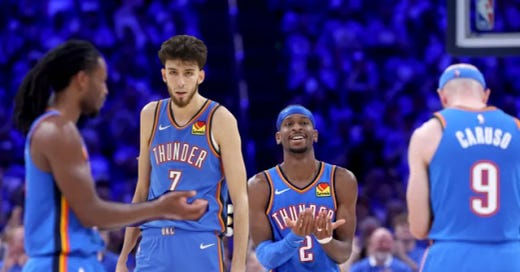Oklahoma City Presents: Thunderbolts*
The Oklahoma City Thunder have a secret weapon, and they’ve only just unleashed it
The Oklahoma City Thunder were the best defense in the regular season by a country mile and have only widened the gap in the postseason. Their 107.5 regular-season defensive rating led the league by 2.1 points per 100 possessions, and their relative defensive efficiency (the distance from league average) of 6.92 points per 100 possessions is the ninth-best figure since 2000-01. In the playoffs, they’ve dropped their defensive rating down to 103.3, a 4.8 points per 100 possessions gap on second, and have a relative defensive efficiency of 9.5 points per 100 possessions.
Needless to say, the Thunder are monstrous on the defensive end, and with both the Boston Celtics and Cleveland Cavaliers falling in the second round, they’re the clear front-runners to win the title. The Thunder don’t need anything extra to win their first championship, but unfortunately for the rest of the league, they just found it with their scarcely used Thunderbolts* lineup.
Who are the Thunderbolts?
Who are the Thunderbolts? Well, they’re not a group of ragtag anti-heroes who have to save the Earth from yet another one-off bad guy; that’s the Suicide Squad. No, these Thunderbolts are the Oklahoma City Thunder’s long-dormant answer to the Golden State Warriors’ death lineup. They’re a defensive unit, so hellaciously tenacious, that they are best described as hellspawn. They’re the Thunder’s blunt instrument of domination. They’re the Thunderbolts for god’s sake.
The four-man lineup of Shai Gilgeous-Alexander, Chet Holmgren, Alex Caruso, and Cason Wallace, in 48 playoff minutes, has a net rating of +46.39 and a defensive rating of 80.41. Yes, there is 100% some small sample opponent 3-point shooting luck (16.13%) going on here, but this lineup was sneakily an absolute monster in the regular season. Primarily due to a lengthy injury absence for Holmgren, this four-man unit only played 36 regular season minutes together. However, when they did share the court, they ripped the limbs off of their opponents and used them as clubs, posting a +42.28 net rating, 86.49 defensive rating, and holding opponents to 35.56% shooting on 2-pointers.
Now, 84 minutes is an incredibly small sample, but it is also almost impossible to fake that level of pure carnage for more than a few minutes, let alone over 80. In their 48 playoff minutes, they’ve held opponents to a 38.4% effective field goal percentage and forced an opponent turnover ratio of 21.2%. While the shooting efficiency will almost surely regress, the downright diabolic turnover numbers might be real. Caruso leads the playoffs in steal percentage at 3.9%, and Wallace is fourth at 3.3%, which is right in line with their regular season marks of 4.0% and 3.1%. Not to mention, Gilgeous-Alexander’s 2.4% steal percentage was the ninth-highest during the regular season.
While the Thunder’s overall postseason numbers are stellar, an 8-3 record, +12.8 net rating, and the postseason’s best defense, they were in a do-or-die game seven against the Nuggets. With all the chips on the table, Mark Daigneault leaned heavily into his secret weapon, playing them 13.4 minutes in game seven, a team high among four-man lineups, and it proved to be the decisive decision.
Thunderbolts Origins: Game Seven
With 5:31 left in the first quarter of game seven, the Thunder found themselves down 21-10. The Nuggets were getting whatever they wanted and at that point, had only committed one turnover. During a pair of Nuggets’ free throws, Chet Holmgren reentered the game to join Gilgeous-Alexander, Wallace, and Caruso for the first time, and the game changed instantly.
The Thunder’s first three defensive possessions with the Thunderbolts saw Caruso force a traveling call on Christian Braun with some of the most intense defense you’ll ever see, a Chet Holmgren block of a Jamal Murray fadeaway, and an Aaron Wiggins block/strip of Russell Westbrook.
Even though the Thunder’s offense was still stuck in first gear, it was clear the game had just changed. In the blink of an eye, the Nuggets went from dictating terms to getting dictated. 12 of the Nuggets’ 22 turnovers were forced in the 13 minutes the Thunderbolts were on the court, and their defensive intensity was the catalyst that flipped an 11-point deficit into a 32-point victory.
It’s not complicated why this four-man unit would absolutely obliterate offenses. Alex Caruso is perhaps the best perimeter defender in the league. He’s a menace on and off the ball and can easily guard up the spectrum, as his game seven harassment of Nikola Jokic showed. Cason Wallace is the compact version of Caruso, and what he lacks in size and strength, he makes up for with speed. Chet Holmgren is an incredibly mobile rim protector, which allows this unit to play incredibly aggressive defense without getting burned on the backend. And Shai Gilgeous-Alexander is a super-long off-ball disrupter who makes the offense elite.
What’s Next for the Thunderbolts?
It took the Thunder until a do-or-die game seven for them to unleash, or perhaps, discover, their best four-man lineup. And now that they have proven themselves, I fear it’s here to stay. Daigneault’s decision to start them in the second half of game seven to extend a 14-point halftime lead to 19 and effectively end the series is a pretty strong indication that he may be ready to go all in on this lineup. Who the fifth man is doesn’t really matter from a defensive perspective, and I’m not entirely sure this isn’t just what happens when you play Alex Caruso, Cason Wallace, and Chet Holmgren together. However, the Thunder were the best team and defense entering the playoffs, have been the best team and defense in the playoffs, and have somehow unlocked a whole new gear. If the Thunder win the title, my money is on the Thunderbolts playing a massive role.
For any inquiries about work, discussion, and the like, you can email me at nevin.l.brown@gmail.com.




